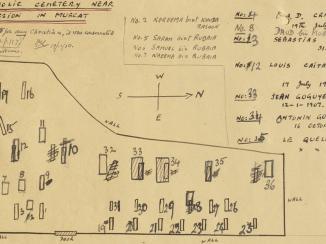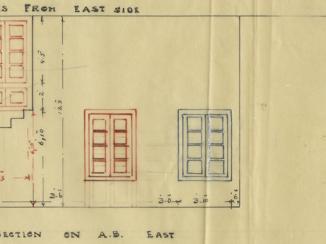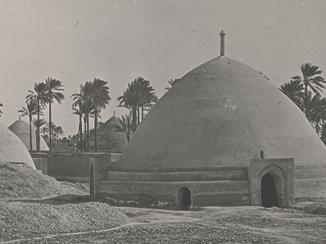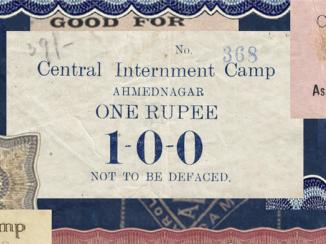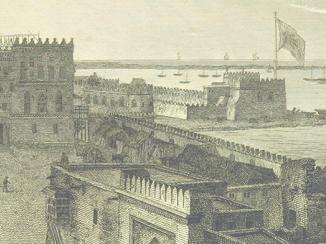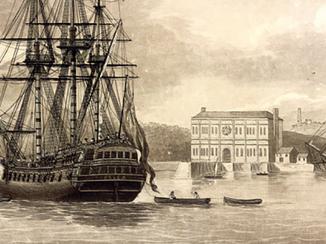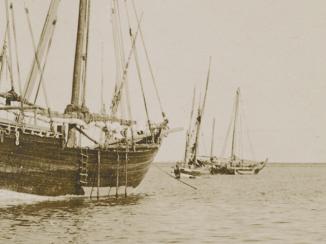Overview
Non-European vessels
Ships have been used to navigate the Gulf for millennia, and non-European vessels appear throughout the India Office The department of the British Government to which the Government of India reported between 1858 and 1947. The successor to the Court of Directors. Records. Mentions range from descriptions by European travellers in the seventeenth century to economic surveys in the twentieth. They appear for various reasons: merchant ships lose their cargo through shipwrecks or hostile activities, while warships attack vessels belonging to other Gulf states. The distinction between civil and military vessels is less clear than with European vessels, as the same boats were often used for pearling or trading, but were also equipped with guns in times of war. The British officials writing about them were not always precise in describing the types of vessels, which can make them more difficult to identify. Not all the non-European vessels described in the records hailed from the Gulf; some were from India, and so their crews and cargoes are often described in the eighteenth and nineteenth centuries as British subjects or British-flagged. Of the many non-European vessels operating in the Gulf, this article describes those which appear most frequently in the records.
The descriptions below use the European classifications outlined in Part 1 of this series, but the sea-faring inhabitants of the Gulf had their own long-standing traditions of making and classifying ships. Although some overlap exists, these local traditions are notably different from European conventions. As a result, the descriptions provided here may not match local descriptions, both past and present.
Types of non-European vessels
Baqqārah: A boat which usually had two masts when it belonged to the Gulf ports, and one when it came from the Iranian or Omani coast. Used for trading, pearl diving, and sometimes warfare, it had a sharp pointed bow with no ornamentation. The term also appears as a bagarah.
Baghlah Large trading vessel. : Large vessels used for trading between the western coast of India and the Gulf. They were on average 30m long, with a crew of over 30. They had two or three masts with lateen sails, and a similar hull to East Indiamen. They also had a curved bow, carved square stern, and quarter-galleries, which had five windows and were usually highly-decorated. Smaller variations were used on the lower parts of the rivers Euphrates and Tigris. They were built in Cochin, the Malabar Coast, and Kuwait, and although primarily used for trade, some were also armed for defence. Early mentions of the baghlah Large trading vessel. sometimes refer to a double-ended type of vessel used as a warship. Also appears as baggalah Large trading vessel. , bugla Large trading vessel. , buggalow Large trading vessel. .
Bajra: A vessel with a flattish rounded bottom and a high stern. It was used as a river boat in India, and might be fully decked or half-decked. In European records it often appears as budgerow, leading to confusion with the baghlah Large trading vessel. .
Batella: A small north-west Indian vessel, used for transporting cargo. It had a square flat stern and a long stem like a ghurāb Shallow vessel with a projecting bow. . Also appears in the records as battela and batel.
Battīl: This was a multi-purpose ship, operating as a pearling vessel, coasting trading vessel, or warship in the eighteenth and nineteenth centuries. It sat low in the water, with a hull that was streamlined at both bow and stern, and a high sternpost with forward-facing projections. It was known for its speed, and was also used by traders in enslaved people. The cargo weight varied from fifteen to 200 tons.
Būm: A double-ended Kuwaiti cargo vessel with a straight, long, pointed stemhead, typically painted black and white. Although mainly a trading ship, it was also used for pearl diving and superseded the larger baghlah Large trading vessel. . It had two masts; the main mast was raked forward, and the mizzen mast behind it was vertical. Some larger models had three masts.
Danqiyyah: A fast Kuwaiti double-ended two-masted vessel with a raked stern. The stem was slightly curved, and often had a bird's head on top facing aft. It was sometimes confused with the trānkī. It appears in the records as dangi.
Dinghi: A small Indian boat, with a settee sail, and a forward-leaning mast, used on the west coast of India. It was sometimes used as a ship’s boat by larger ships. Dinghi became the Anglo-Indian term dinghy, which was used for small passenger and cargo river boats.
Dhow A term adopted by British officials to refer to local sailing vessels in the western Indian Ocean. [dāw]: A term adopted by British officials to refer to local sailing vessels, typically with lateen sails, used in the western Indian Ocean. The term is of uncertain origin, and is sometimes used as an umbrella term for non-European vessels, and sometimes used to refer to more specific types of vessel. Whether British uses corresponded to local uses of the term is uncertain.
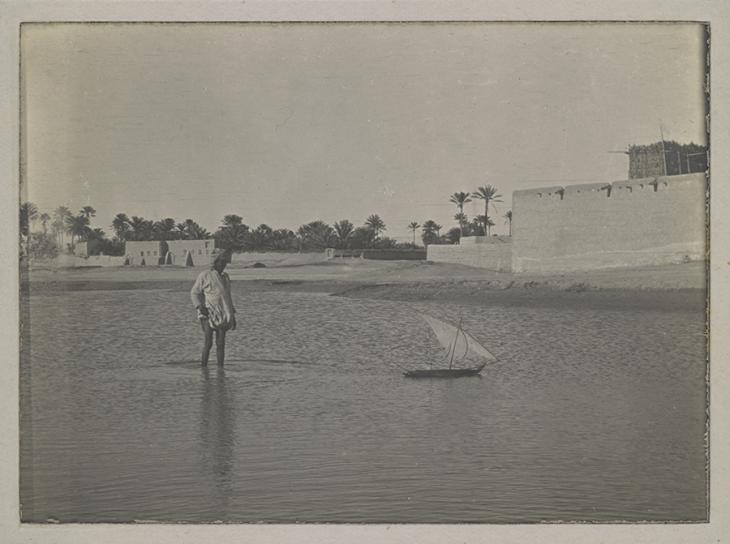
Gallivat: Warship built with one or two masts with settee or lateen sails, and also propelled by oars. It had a similar shape to the ghurāb Shallow vessel with a projecting bow. , and carried swivel guns or small cannons. By the nineteenth century, its function had changed and it was used as an all-purpose coastal boat. It developed into the jālbūt.
Ghanjah: These vessels were built at Sur. It was very similar to the baghlah Large trading vessel. and the kūtiyyah. It was characterised by a square high stern, though with less elaborate carving than the baghlah Large trading vessel. , and had a deck overhanging the stern. Its two or three masts were all lateen-rigged. Ghanjahs varied in size from small vessels carrying twenty tons of cargo to larger vessels measuring 100 feet long. It appears under different names in British records, including gooncha.
Ghurāb Shallow vessel with a projecting bow. : This vessel had a projecting bow and two or three masts, common in India and the Gulf. It was sometimes armed, and was relatively shallow and broad, with a square stern. Also known as the grab Shallow vessel with a projecting bow. .
Jālbūt: A coastal boat from the northern Gulf which developed from the gallivat. It had an upright stem, a flat stern, and a single mast. Large jālbūts were used as pearlers, fishing vessels, and cargo boats, while smaller ones were carried on board larger vessels. Appears in the records as jalbut.
Kūtiyyah: This vessel was very similar to, and was often confused with the baghlah Large trading vessel. and the ghanjah. All three had rear windows, and together they were the main ocean-going vessels in the region. However, the stem on a kūtiyyah was carved with a parrot head motif facing inward, whereas on the baghlah Large trading vessel. it was plain. The kūtiyyah also had a rounded stern, while those on the ghanjah and baghlah Large trading vessel. were square. The kūtiyyah was mainly used as a fast cargo craft, rather than as a warship. The design may have been adapted from Indian boats. It also appears in British records as kotia or cotteya.
Lanj: A generic term in the Gulf for a fishing or cargo vessel with a flat stern. Also appears as lanch, lansh, ling, or leng.
Muhaylah: An Iraqi vessel with one fore-and-aft mast used for transporting cargo along rivers.
![Photograph of a muhaylah at anchor in Mohammerah [Khorramshahr], 1917. Photo 496/6/42](https://www.qdl.qa/sites/default/files/styles/standard_content_image/public/photo_496_6_0049_crop_web.jpg?itok=Qfir3SAX)
Nauri: An Indian vessel built on the north-west Indian coast, similar to the danqiyyah. Like the kūttiyah, the nauri had a curved bird’s head, with a crest on the stemhead. It sometimes appears in British records as nowry.
Pattamar: A fast Indian coaster, influenced by Arab and European designs, characterised by a rounded stern (similar to a kūtiyyah) and a long, tall stem. It had two or three masts with lateen sails. If there were only two masts, they raked forward at a pronounced angle, while the third (if present) would be upright. It carried a cargo of around sixty to 180 tons, and because of its speed was often used to carry messages.
Sunbūk: This originally referred to a double-ended, flat-bottomed vessel in Oman and the southern Arabian coast. The double-ended model persisted in Bahrain, but elsewhere the sunbūk developed into a partially decked vessel with a flat and high stern in the shape of a shield, a curved stem, and a low bow. The keel was short, making them easily manoeuvrable, and they were often used as fishing boats. The term eventually came to be used more generically both locally and in British records to refer to any sailing boat. Appears in British records as sanbuq, and in Portuguese as the sambucho or zambuk.
Shāshah: A canoe made from the spines of date palm leaves sewn together. It was used as a fishing boat and powered by oars or a settee sail. It was flexible and could be used in rough weather, but had to be left to dry after becoming waterlogged, and before being used again.
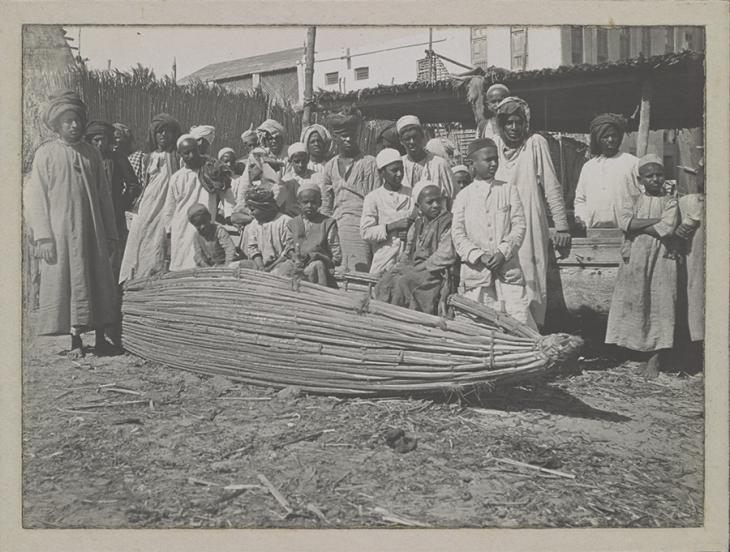
Shūʿī: Almost identical to the sunbūq but with a straight stem ending in a double curve at the stemhead. The tip of the stemhead was usually painted blue. It had a transom stern with planks projecting beyond it, which looked like fins. It was about fifteen to twenty feet long, and carried a crew of six to ten fishermen. It appears in British records as shoee.
Trānkī: A large, fast, and armed vessel, used for transport, trading, and war from the sixteenth to eighteenth centuries. It had a low stempost, a high stern, and carried one mast. It should not be confused with the trānkeh, a small, undecked double-ended boat used for pearl fishing.



